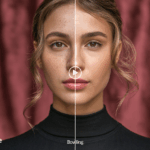Did this ever happen to you? You catch your pet looking irresistibly cute and grab your camera and snap a picture. When you view it, suddenly, instead of looking cute, they look like some demon possesses them. Their eyes are glowing white or some other unnatural eye color.
Don’t panic and call an exorcist, just launch Photoshop Elements to easily fix white eyes. Follow this pet photography tip to restore your pet’s eyes and their cuteness.
STEP 1
Open an image of an animal with a white eye. Drag the background layer onto the Create A New Layer icon in the Layers palette. That way, we will fix white eyes on a separate layer.
The photo below is of our dog Lydia. Lydia is the sweetest golden retriever ever and you can see she loves her creature comforts. But with that white pet eye glowing, it’s hard to imagine how lovable she is.
STEP 2
Zoom in on a white eye. Make sure you click on the Background Copy layer in the Layers palette so you don’t make any changes to the Background layer. Select the Zoom tool from the Toolbox. Click on one of the eyes you want to fix. Continue to click while watching the zoom amount at the lower-left corner of your image. Click until you’re zoomed in to at least 300%.
STEP 3
Make a selection of the area that needs fixing. Choose the Magic Wand tool from the Toolbox. Up in the Options, bar make sure the tolerance is set to 32.
Click once in the white area of the eye. That area will be selected as indicated by the marching ants. But we’re going to refine our selection, so click on the Refine Edge… box up in the Options bar.
STEP 4
Refine your selection. Now, you should see the Refine Edge dialog box. For this example of how to fix white eyes, we’ll leave the Smooth amount at 0. Change the Feather amount to 1 pixel. By Feathering the selection, we create a soft-edge transition between the selected and non-selected areas. Slide the Contract/Expand amount all the way over to +100%. That will slightly expand our selection into the surrounding area. We want to make sure we fix white eyes completely.
Below the slider controls in the dialog box, there are two different view modes to choose from. The one on the left is the Standard view, which shows you the marching ants selection. The one on the right is the Custom Color Overlay view.
I prefer the Custom Color Overlay view because it gives you a more accurate view of your selection. The area that has the overlay of red on it is the non-selected area. Your selection is the non red eye removal area. Switch to that view from the Standard view (you can toggle between views by pressing the F key). Now, you can clearly see how your selection goes into the surrounding area around the pupil as a result of our Contract/Expansion setting. You can also see how the edge of the selection is slightly soft as a result of our Feather setting. Our next step also takes advantage of the Custom Color Overlay view.
STEP 5
Add a glimmer of light. To make this fix white eye effect more realistic we are going to add a sparkle to the eye. With our example, we have a reflection spilling outside of the pupil area, as you can see from the picture below. That makes it easy for us to decide where to add to our selection.
If you don’t have an obvious reflection, just add one at about the 5 or 7 o’clock position of the pupil.
Now, choose the Selection brush from the Toolbox. Up in the Options bar, choose a soft brush. Set the size to 2 pixels. From the Mode window, choose Mask.
Your image will now be overlaid with red again. Now you can use the Selection brush to paint in a reflection at the 5 or 7 o’clock position. Don’t make it too big, we want it to be subtle so it looks real. You can change the size of your brush by pressing the left and right bracket keys [ ]. Your cursor, which is now a circle, will change size as you press the bracket keys, indicating the size of your brush.
STEP 6
Change to black. Once you have your selection done, press the D key to ensure that your Foreground and Background colors are set to their default black and white. The Foreground and Background icons are the two overlapping squares at the bottom of the Toolbox. Press the Alt Key + Backspace (Mac: Option + Delete) to fill your selection with your Foreground color, which should be set to black. Now just press the Control key (Mac: Command) + D to Deselect. Change your view back to 100% by double-clicking on the Zoom tool.
I lowered the Opacity on my Background copy layer to 90% because I thought it looked more natural. You can try this by going to the Layers palette and in the Opacity window at the top right, click and slide it to the left until you get to 90. You can also just press 9 (Nine) on your keyboard.
There, Lydia looks like her old sweet self again! And that’s how you can fix white eyes in your pets’ photos.
Here’s the before and after:
That wraps up this Photoshop Elements tutorial on how to fix white eyes. Below this page, you can find more Photoshop Elements tutorials.
If you have comments, questions or requests please don’t hesitate to use the Contact form to let me know.
Source: http://www.essential-photoshop-elements.com/fix-white-eyes.html
















